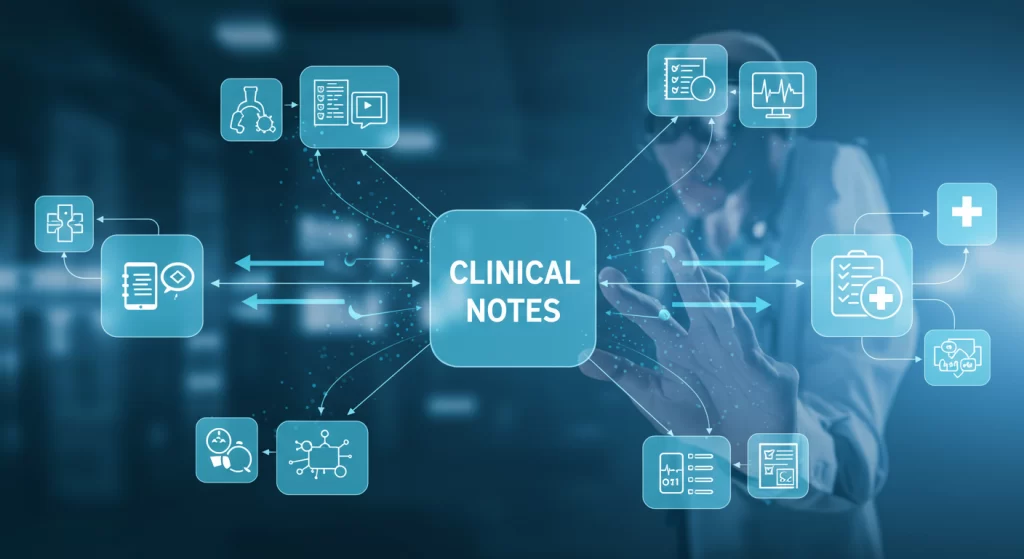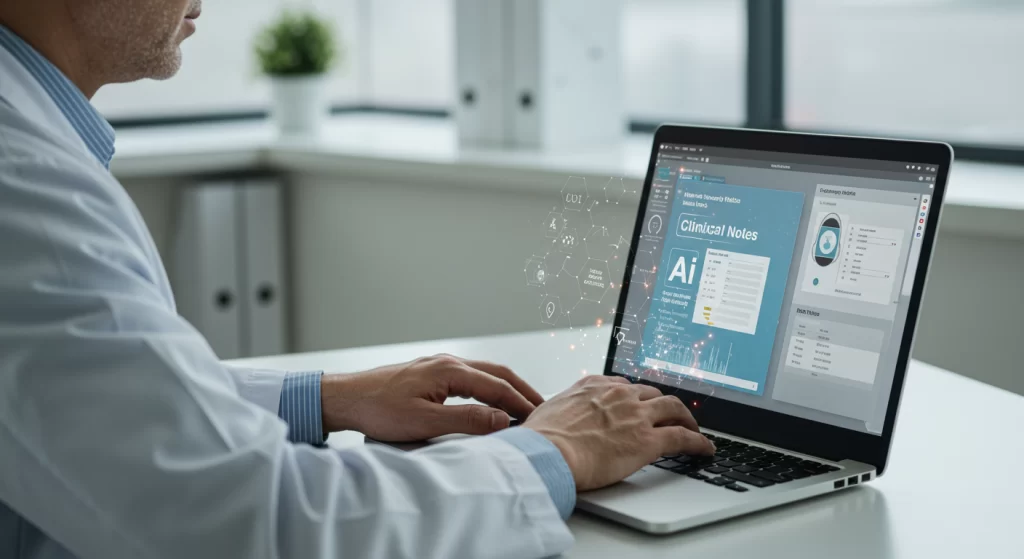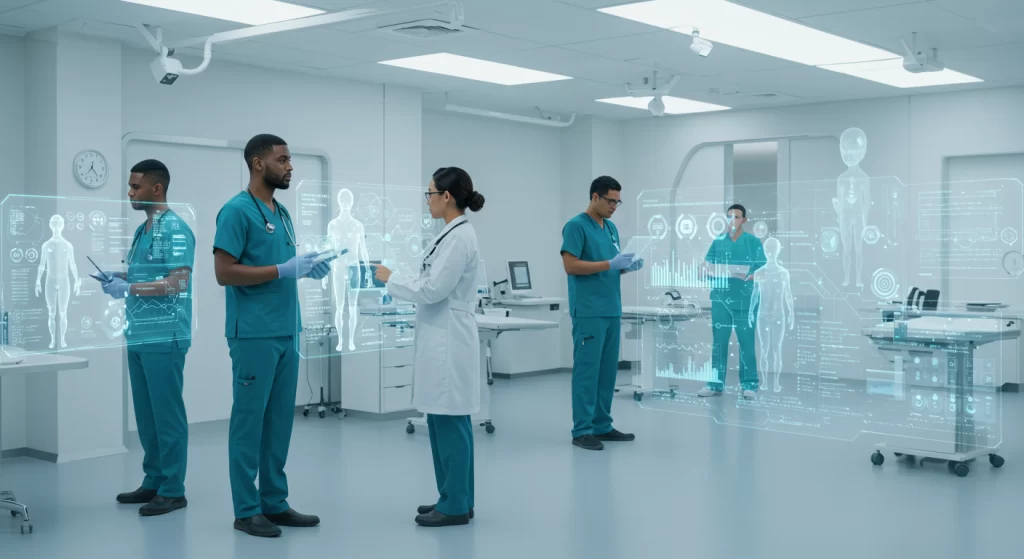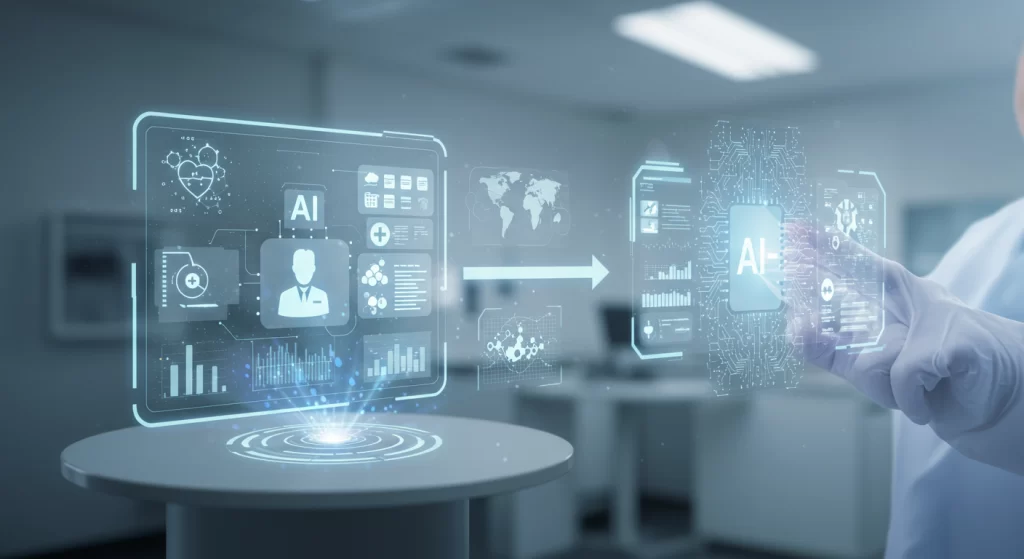Clinical documentation is vital in healthcare but places a heavy burden on clinicians. Physicians often spend 34% to 55% of their workday on documentation within electronic health records (EHRs), averaging 15.5 hours weekly on paperwork. This administrative load carries a significant opportunity cost, estimated at $90-$140 billion annually in the US, representing time lost from direct patient care. This burden contributes significantly to clinician burnout, a major issue affecting the healthcare workforce. While essential for care quality, billing, and communication, traditional documentation methods lack efficiency.

Enter clinical notes AI, a transformative technology designed to streamline the creation, management, and analysis of clinical documentation. The goal of clinical notes AI is to significantly boost documentation efficiency and accuracy, reduce administrative tasks, and enable clinicians to focus more on patient care. The rapid growth of AI in healthcare, with market forecasts predicting substantial expansion, highlights its potential. This guide explores clinical notes AI technology, its implementation, advantages, security, and impact, examining how AI for clinical notes is reshaping workflows.
Feeling overwhelmed by medical documents? Check how we can develop and integrate custom healthcare AI agents to effectively streamline your clinical workflows!
Decoding Clinical Notes AI: The Tech Behind the Transformation
Clinical notes AI uses artificial intelligence specifically to automate and improve clinical documentation in healthcare. It involves technologies that go beyond simple transcription, understanding medical language, extracting relevant information, structuring it, and integrating it into EHRs. The primary aim is to lessen the administrative load associated with documentation. By automating manual tasks, clinical AI notes solutions seek to:
- Boost documentation speed and efficiency
- Improve the accuracy and completeness of records
- Reduce clinician burnout by saving time
- Allow more focused patient interaction
- Potentially aid downstream tasks like coding and billing
Core Techs: NLP, ML, and Ambient Intelligence in AI for Clinical Notes
The effectiveness of clinical notes AI comes from key AI technologies:
- Artificial Intelligence (AI). The foundation, enabling systems to perform tasks requiring human intelligence.
- Natural Language Processing (NLP). Crucial for understanding and generating human language, vital as much healthcare data (up to 80%) is unstructured narrative text. NLP handles speech-to-text conversion, extracts key medical concepts (diagnoses, symptoms, medications), interprets context, and structures data for EHRs.
- Machine Learning (ML). A subset of AI where systems learn from data to improve performance. Trained on vast medical datasets, ML models in clinical AI notes enhance speech recognition accuracy, recognize patterns, detect errors or inconsistencies, potentially predict information, assist with coding, and improve over time.
- Ambient Clinical Intelligence (ACI) / AI Scribes. Technologies operating passively during patient visits. Using microphones, they listen to conversations, filter relevant dialogue, and automatically generate draft clinical notes (e.g., SOAP format). This differs significantly from traditional dictation.
The evolution from basic dictation to ambient AI reflects progress: simple transcription -> NLP for understanding/structuring -> ML for accuracy/patterns -> ACI for seamless integration. However, the reliability of clinical notes AI depends heavily on the quality of the data it’s trained on and interacts with. Biases or inaccuracies in source data can be perpetuated, and poor EHR data quality can limit AI effectiveness, highlighting the need for strong data governance.
Adding Value: The Advantages of AI-Generated Clinical Notes
Adopting clinical notes AI brings compelling benefits, addressing key healthcare pain points. These AI-generated clinical notes advantages cover efficiency, accuracy, quality, clinician well-being, and patient care.

Supercharging Efficiency: How AI-Generated Clinical Notes Efficiency Saves Time
A major benefit of clinical notes AI is dramatically reducing documentation time. This AI-generated clinical notes efficiency comes from automating manual typing, review, and structuring.
Quantifiable Time Savings
Impact varies, but potential is tremendous:
- Gartner Prediction. By 2027, clinicians could cut documentation time by 50% using generative AI integrated into EHRs.
- Study Examples. Reports show physicians saving nearly 2 hours daily, around 1 hour daily, or experiencing a 20.4% reduction in note time per appointment. Chart closure times can drop significantly.
- Reduced After-Hours Work. AI decreases “pajama time” (documentation outside work hours). One study noted a 30% decrease.
Workflow Streamlining
Clinical notes AI streamlines the entire documentation workflow by automating data entry, structuring information, and potentially suggesting codes, facilitating quicker information sharing.
However, the net efficiency gain depends heavily on the accuracy of AI notes and the time needed for clinician review and correction. Frequent errors can negate time savings. Higher adoption rates also correlate with greater time savings. Thus, AI-generated clinical notes efficiency is achieved through careful selection, implementation, and refinement.
Accuracy and Quality Gains with Clinical AI Notes
Clinical AI notes can improve the accuracy, completeness, and quality of documentation, another key AI-generated clinical notes advantage.
- Improved Accuracy. Automation minimizes human errors like typos or omissions. AI handles complex medical terms well.
- Enhanced Completeness & Specificity. AI can prompt for details or highlight missing information, supporting Clinical Documentation Integrity (CDI). Some studies show AI capturing more relevant findings.
- Error Detection. AI can spot inconsistencies within notes or against patient history and flag potential coding errors.
- Standardization. AI enforces consistent terminology and structure (e.g., SOAP format), improving clarity and comparability.
Accuracy Considerations:
Accuracy metrics vary:
- Specific Tasks. High accuracy reported for tasks like classifying patient race (F-scores 0.911-0.984) or smoking status (F-score 0.981).
- Vendor Claims. Often high (94-99+%), sometimes compared favorably to models like GPT-4.
- Limitations. Moderate accuracy reported for some real-time tools. Risk of errors like omissions or “hallucinations” (plausible but incorrect info) exists, especially with GenAI.
The Critical Role of Clinician Review
Given potential errors, clinicians must review, edit, and approve all AI-generated notes. The clinician remains responsible for accuracy. Tools offering transparency (e.g., tracing text to conversation sources) aid verification. Evaluating AI requires looking beyond simple accuracy percentages to consider error types, reliability, and review efficiency.
Elevating Patient Care and Reducing Clinician Burnout
The AI-generated clinical notes advantages impact both patients and providers by addressing the documentation burden. Clinical notes AI and AI for clinical notes contribute to better interactions and well-being.
- Improved Patient Focus. Saved documentation time means more face-to-face patient engagement. Ambient AI scribes allow better eye contact. Patients notice this improved interaction, potentially boosting satisfaction and trust.
- Reduced Clinician Burnout. Documentation burden is a primary burnout driver. Clinical notes AI tackles this by automating notes and reducing “pajama time”. Studies show AI tools improve perceptions of documentation burden, reduce burnout risk, and increase job satisfaction.
- Enhanced Clinical Decision Support (CDS). Accurate, structured AI-generated data improves the foundation for CDS systems, enabling more relevant alerts and recommendations.
- Improved Patient Safety. More accurate documentation, reduced human error, AI error detection, and increased clinician focus contribute to safety.
Implementing clinical notes AI is a strategic intervention targeting a systemic burnout driver while enabling better patient connection, positioning it as a key asset for quality care and workforce sustainability.
Putting AI to Work: Implementing Clinical AI Notes Solutions
Successful implementation of clinical notes AI requires careful planning and a structured approach for integration, adoption, and achieving goals.

A Step-by-Step Approach to Integration
Effective integration of clinical AI notes needs planning. An enterprise AI strategy helps. Key steps include:
- Assessment & Goal Setting. Define clear objectives (e.g., reduce time, improve quality, cut burnout). Identify high-impact workflows. Assess infrastructure and data quality.
- Tool Selection. Evaluate vendors based on goals, accuracy, usability, EHR compatibility (Epic, Cerner), security, scalability, support, and cost. Involve stakeholders (clinicians, IT, compliance).
- Workflow Integration Planning. Map how the AI for clinical notes tool fits into existing workflows to minimize disruption. Plan data flow with the EHR.
- Training and Onboarding. Provide comprehensive training on tool use, effective review/editing, limitations, and best practices. Emphasize clinician responsibility.
- Pilot Program & Phased Rollout. Start small to test, gather feedback, resolve issues, refine workflows, and build trust before wider rollout. Implement feedback loops.
- Monitoring & Evaluation. Track KPIs (documentation time, note completion, satisfaction, accuracy). Continuously monitor performance and use metrics for evaluation and optimization.
AI-Generated Clinical Notes Best Practices for Success
Adhering to AI-generated clinical notes best practices is vital:
- Clinician Oversight is Non-Negotiable. Clinicians must review, edit, and approve AI notes before finalization.
- Establish Clear Governance and Policies. Develop frameworks covering data privacy (HIPAA), security, ethics, bias mitigation, transparency, and liability.
- Prioritize Transparency and Explainability. Choose tools offering insight into their process. Communicate capabilities/limitations openly. Inform patients appropriately.
- Actively Monitor for and Mitigate Bias. AI can inherit data biases. Monitor outputs for fairness across demographics. Use diverse training data where possible.
- Focus on User Experience (UX) and Workflow Fit. Tools must be intuitive and integrate smoothly. Customization enhances adoption.
- Implement Continuous Quality Improvement (CQI). Use feedback mechanisms. Analyze performance, update models cautiously, and refine workflows.
Successful implementation involves managing human and organizational change: building trust, ensuring usability, providing training, and setting ethical guardrails.
Trust in Focus: AI-Generated Clinical Notes Data Security
Robust AI-generated clinical notes data security and trust are critical when implementing clinical notes AI, requiring focus on compliance, data protection, and ethics.

Ensuring HIPAA Compliance and Data Privacy
Adherence to HIPAA (and similar regulations like GDPR) is mandatory for handling Protected Health Information (PHI). Key safeguards include:
- Business Associate Agreements (BAAs). Legal contracts with vendors outlining PHI protection responsibilities.
- Essential Security Measures:
- End-to-End Encryption. Encrypt PHI in transit and at rest (e.g., AES-256).
- Strict Access Controls. Use MFA, SSO, and Role-Based Access Controls (RBAC).
- Data De-identification/Anonymization. Properly de-identify data used beyond direct care (e.g., for AI training). Transparency is key.
- Secure Infrastructure. Use secure data centers with physical security. Certifications like SOC 2 or HITRUST provide validation.
- Comprehensive Audit Logs. Maintain detailed logs of PHI access and changes.
- Regular Audits. Conduct regular security audits and vulnerability assessments.
Data Storage Explained (Cloud vs. Local)
Regarding AI-generated clinical notes data security and storage:
- Predominantly Cloud-Based. Most solutions are cloud-based SaaS, offering scalability and accessibility.
- Cloud Security. Reputable providers (AWS, Azure, Google Cloud) offer secure environments, but vendors/organizations must configure security correctly. Encryption and access controls are vital.
- Local Storage. Less common for core AI processing, but some components might involve local elements.
- Zero Data Retention. Some vendors minimize risk by not storing sensitive data long-term after processing.
- Vendor Vetting is Key. Rigorously vet vendor security, policies, and certifications (HIPAA, SOC 2) regardless of storage location. BAAs should define storage/retention protocols.
Addressing Ethical Considerations
AI-generated clinical notes data security includes ethical aspects:
- Bias Mitigation. AI can reflect data biases. Actively monitor for fairness and use diverse training data.
- Transparency and Explainability. Aim for interpretable AI models. Explainability fosters trust.
- Accountability and Liability. Clinicians remain accountable for note content. Policies should address error handling.
- Patient Data Usage. Be transparent about using (even de-identified) data for training. Ensure compliance and ethical standards.
- Impact on the Human Element. Ensure AI augments, not replaces, empathy and clinical judgment.
Building trust requires a holistic security approach: technical safeguards, compliance, governance, transparency, and addressing ethical dimensions.
Scaling for the Future: EHR Integration and AI-Generated Clinical Notes Scalability
Effective EHR integration and AI-generated clinical notes scalability are crucial for widespread adoption and realizing the full benefits of clinical notes AI.
Integrating Clinical AI Notes with Epic, Cerner, and Other EHRs
Seamless integration between clinical AI notes solutions and EHRs (like Epic, Cerner, Athenahealth, etc.) is vital for efficiency. Manual data transfer is inefficient and error-prone.
- Compatibility is Key. Leading vendors promote integration capabilities using standards like HL7 or FHIR APIs.
- Integration Challenges. Hurdles include technical issues (data mismatches, API delays), workflow disruption, data consistency problems, security risks during transfer, and limitations due to poor underlying EHR data quality.
- Advanced Integration (Bi-directional Sync). Sophisticated integrations allow data flow both ways – pushing notes to the EHR and pulling context (history, labs) from the EHR to improve note generation.
Ensuring AI-Generated Clinical Notes Scalability and Adaptability
AI-generated clinical notes scalability involves technical capacity and functional adaptability.
- Technical Scalability. Cloud architectures generally offer scalability to handle more users and data.
- Adaptability to Specialties. Healthcare requires specialization. AI models need to be adaptable or trained for different fields (oncology, cardiology, etc.). Look for specialty-specific models or customization.
- Adaptability to Workflows. Solutions must fit diverse settings (inpatient/outpatient) and encounter types. Mobile device support enhances flexibility.
- Learning and Improvement. ML-based systems can improve over time with more data and feedback.
True scalability requires both tech capacity and functional adaptability to diverse clinical needs.
Meeting Diverse Needs: Note Formats, Coding, and Languages
Effective clinical notes AI must meet varied documentation needs.
- Supported Note Formats. Many platforms generate standard formats like SOAP notes, progress notes, and discharge summaries. Customizable templates are often available.
- Medical Coding Assistance. AI can suggest or assign codes (ICD-10, CPT, SNOMED CT) based on documentation, improving accuracy and efficiency for billing and analytics. Some support HCC coding.
- Input Methods. Support often includes ambient listening, direct dictation, and sometimes processing summaries or text.
- Language Support. Some platforms offer multilingual capabilities for transcription and note generation.
Table 1. Clinical Notes AI Feature Support Matrix
| Feature | Common Support Level |
|---|---|
| SOAP Notes | Commonly Supported |
| Progress Notes | Commonly Supported |
| Discharge Summaries | Often Supported |
| ICD-10 Coding Support | Increasingly Common |
| SNOMED CT Coding Support | Varies by Vendor |
| CPT Coding Support | Varies by Vendor |
| Voice Input (Ambient Listening) | Key Feature of Many Tools |
| Voice Input (Direct Dictation) | Commonly Supported |
| Keyboard/Text Input Processing | Sometimes Supported |
| EHR Integration (General) | Essential / Widely Claimed |
| EHR Integration (Epic/Cerner Specific) | Often Supported |
| Multi-language Support | Available in Some Tools |
| Mobile/Tablet Access | Often Available |
| Custom Templates | Often Available |
Final Thoughts
Clinical documentation is being transformed by clinical notes AI. These techs offer solutions to the administrative burden in healthcare. By using AI, NLP, and ML, clinical AI notes systems enhance AI-generated clinical notes efficiency, improve documentation quality, and allow clinicians more time for patient care, reducing burnout.
Realizing the potential of AI for clinical notes requires strategic implementation, focusing on workflow integration, training, and AI-generated clinical notes best practices. Ensuring robust AI-generated clinical notes data security, HIPAA compliance, ethical governance, and AI-generated clinical notes scalability (adapting to specialties and settings) are crucial.
The evolution of clinical notes AI continues, promising greater accuracy, deeper integration, better decision support, and broader coverage. For healthcare organizations, strategically adopting clinical notes AI offers a significant opportunity to boost efficiency, support clinicians, and improve patient care quality.
Ready to transform your clinical documentation? Partner with SPsoft to leverage our deep experience in healthcare AI development and integration! Contact us right now!
FAQ
How does AI help with medical note-taking and documentation?
AI automates transcription, extracts key medical info, structures it (e.g., SOAP notes), and integrates with EHRs, saving time, reducing errors, and freeing clinicians to focus on patients.
How is it different from traditional voice dictation or transcription tools?
Traditional tools mainly do speech-to-text. Clinical notes AI understands medical context, filters conversations, structures notes automatically, extracts data, and suggests codes, often working ambiently.
How accurate are AI-generated clinical notes?
Accuracy varies. High performance is seen in specific tasks, and vendors claim high rates. However, errors like omissions or “hallucinations” can occur. Clinician review is essential. Accuracy can improve with ML.
Can doctors edit or review the notes before signing off?
Yes, this is a crucial best practice. Clinicians review, edit for accuracy, and approve AI notes before finalization, retaining ultimate responsibility.
Can Clinical Notes AI integrate with EHR systems like Epic or Cerner?
Yes, integration with major EHRs (Epic, Cerner, etc.) is a key feature for most leading solutions, often using APIs like FHIR.
Does it support SOAP notes, progress notes, and discharge summaries?
Yes, many tools generate standard formats like SOAP notes, progress notes, and discharge summaries, often with customizable templates.
How is patient data secured during processing?
Through robust AI-generated clinical notes data security measures aligned with HIPAA: end-to-end encryption, strict access controls, secure data centers, audits, de-identification where appropriate, and BAAs.
Are the notes stored locally or in the cloud?
Most solutions are cloud-based for scalability. Security protocols are vital regardless of location. Some vendors offer zero data retention.
Can it adapt to different specialties and clinical workflows?
Yes, adaptability is key. Solutions often offer specialty-specific models or customization for different medical fields and workflows (inpatient/outpatient).
Does it support multiple languages or medical coding (ICD-10, SNOMED)?
Advanced tools often support medical coding (ICD-10, CPT, SNOMED CT). Some also offer multi-language support.



